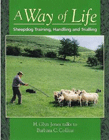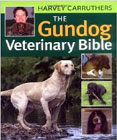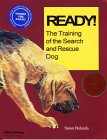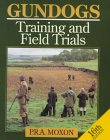Sheepdog, Gundog and Scent Work
If you want to buy a book, clicking on the book cover will take you directly to that book on the Amazon.co.uk web site.
See also:

Eminent Dogs, Dangerous Men: Searching Through Scotland for a Border Collie
Eminent Dogs, Dangerous Men is a hymn of praise to working border collies and their shepherds. The 'eminent dogs' are those collies which achieve miracles at sheepdog trials, and the 'dangerous men' are their handlers, shepherds who, like border collies, work 'because', because when you are working, you become whole, and for a short while after you have performed such a miracle, you understand the meaning of life.
Border collies come from Britain, and you can find them wherever there are sheep, especially in Wales and Scotland. They are also very popular as pets in Britain. Some of the most remarkable writing on border collies has, however, come from the United States. 'Do Border Collies Dream of Sheep?', also reviewed on this page, is the story of two collie littermates, born in the US. Eminent Dogs is the story of Donald McCaig's quest in Scotland for a well-bred collie, already able to work, to help him on his sheep farm in western Virginia. His ancestors came from Scotland, first driven to Glasgow by the Highland Clearances, and then seeking their fortune across the water. The Clearances followed Bonnie Prince Charlie's defeat at the hands of the English. First, there was a mass slaughter. Then big landowners evicted people from their homes because they were no longer needed. Sheep had become profitable, the landowners wanted to make money, and few workers are needed for farming sheep. There was work for shepherds in the Highlands, but most families had to leave for the cities.
Read more: Eminent Dogs, Dangerous Men: Searching Through Scotland for a Border Collie

Do Border Collies Dream of Sheep? Full Color Edition
This is the story of two littermate border collies. One, May, stayed on a farm in North Carolina with her breeder, Denise Wall, to work sheep. The other, Sky, went to live in New York with Carol Lea Benjamin, writer, trainer and illustrator, to become a service dog, with special privileges to go places where dogs are usually not allowed, such as on buses. The story tells how each dog-human pair learnt to communicate with one another so that each dog could do a very important job. Their jobs were very different, yet when the sisters met again as adults in North Carolina, Sky quickly got the hang of working sheep. Border collies have an inbuilt understanding of sheepdog work, hence the title of the book.
This is a fascinating story for anyone interested in canine-human communication, and how dogs can learn complex tasks. In each case the tasks go beyond simply obeying commands. The dogs come to learn that there is a wider goal, in May's case, for example to bring in sheep, in Sky's case, to ease pain. Each dog may sometimes take the initiative over the details of how the goal is achieved. This can mean disobeying commands that don't fit with the wider goal. Carol, for example, mentions that her other service dog, Flash, once insisted on lying on her to provide pain relief in a crowded cinema. Carol herself had not wanted to recognise the pain was there. This reflects the relationship of service dogs and their owners described by another writer, Csanyi. He mentions a guide dog which refused to let his owner take a step forward. The dog knew there was an unexpected pothole just ahead, and the owner did not.
Denise and Carol are talking about a relationship with their dogs, and two-way communication. How did they develop such good relationships? Before continuing with the story of May and Sky, I will backtrack to where the book starts, a chapter by Carol on how the wolf became the dog.
Read more: Do Border Collies Dream of Sheep? Full Color Edition

A Way of Life: Sheepdog Training, Handling and Trialling
A Way Of Life is a classic, which both provides a step by step guide to sheepdog training, and helps you understand what makes your dog tick. It can be read for enjoyment, or for advice on starting out in training. While this book is extremely helpful for novices who want to train their dogs, it is more useful if used together with Andy Nickless´s DVD, First Steps In Border Collie Sheepdog Training, which shows more directly what is involved. This book is also part of our heritage. Sheepdog skills have been handed down from shepherd to shepherd, dog to dog, and it´s a real delight to read the work of someone who is steeped in the skills.

First Steps In Border Collie Sheepdog Training [DVD]
This is a set of two DVDs from a modern trainer, which is extremely useful for beginners to sheepdog training. It sets out both how to train the basics, and common problems and how to tackle them. It's also a DVD that will help you understand the body language of your collie, an understanding that is useful whether or not you want your dog to work sheep. Some of the ways that collies communicate are common to all the breed, but the way they 'eye', for example, can vary a lot from one dog to another. Watch this video, and you will have more insight into your dog as an individual, and more respect for what the breed is capable of.

The Gundog Veterinary Bible [Illustrated] (Spiral-bound)
The Gundog Veterinary Bible a very useful manual for anyone who likes an active life with their dog, not just gundog owners. There is help on what to do in emergencies, such as when a dog has eaten something poisonous, or broken a leg. There is also advice on preventing problems, which is well worth reading, so that you do not have to use the advice for emergencies. The author is the vet columnist of Shooting Times, Harvey Carruthers MRCVS.
The book is very accessible, clearly written, with good illustrations. It is a handy size to take on journeys, and is also spiral bound, so it stays open on a car seat, which means that you can follow instructions and check on the dog at the same time. Very highly recommended.

Practical Scent Dog Training
Lue Button has written a very accessible book for anyone interested in scent dog training, whether tracking, trailing or air scenting. This is a practical guide which you can use for working on your own, or with a friend.. It is full of common-sense advice, such as the need to develop your powers of observation and discover how your dog tries to communicate with you. The first six chapters are helpful for all owners, and go a long way towards helping people to develop canine skills, and a better relationship between dog and owner. There are useful preliminary exercises for pups, useful for all pups, not just those destined to become professional scent dogs.
The bulk of the book comprises lesson plans for different types of scent work. The lesson plans are clearly set out, with good illustrations in the form of line drawings. There is enough information to help experienced scent dog people who are encountering problems with a particular book. The joy of this book, however, is that is is an eye-opener for any owner who wants to do interesting activities with their dog. Highly recommended, a gem of a book.

Tracking Dog: Theory & Methods
This short book is the 'bible' for trackers from an innovative and highly experienced handler. Johnson has a wide range of experience from finding poison leaks, to work with dogs in the armed forces. A 'must-read' for anyone seriously interested in teaching tracking skills to their dog.

Ready: the Training of the Search and Rescue Dog
This is a classic 'how to' book for training Search and Rescue (SAR) dogs. It's very easy to follow, and gives you a very clear idea of the training needs of SAR dogs. The rationale behind the training procedures is explained well, including how handlers should be trained! There is a troubleshooting guide for helping handlers tackle common problems. The book is also very well illustrated. This is a very useful resource for dog clubs, as well as owners interested in SAR work.

Search and Rescue Dogs: Training the K-9 Hero
Search and Rescue (SAR) dogs save lives - wandering toddlers, people trapped in collapsed buildings, or lost in the wilds. This is a gripping account of their achievements, with advice on how to train them. This account will give you new respect for the abilities of dogs. Not all dogs are suited to high-level SAR work, but it is possible to train any dog to do some of the things that SAR dogs do. Training dogs to find people on command can bring benefits in terms of improving communication between you and your dog, and because dogs like to be given jobs to do. You can also train dogs to find other dogs, which is very useful if you have more than one dog, and one gets lost. You can even train dogs to find missing objects, like your car keys!

Gundog Training Made Easy
This is a short book, but packed with enough information to teach your dog the basics of gundog work. It is very easy to follow, and is geared to pet owners, in that the methods used are those that pet owners tend to feel comfortable with (ie no ear pinching or electric shocks). It won't take you very far, but if you are starting out, it's much easier to understand this guide than many others which give you more information than you can take in at first.

The 10-Minute Retriever
Amy and John Dahl are highly respected trainers in US retrieving circles, though some of their methods are now seen as old fashioned by many pet dog trainers. A British pet owner reading their book is making an exploration into a different dog culture. The dogs trained by the authors, and described in this book are expected to win competitions. If they don’t do their jobs well, they are given to other owners as pets. Pet dogs in Britain tend to be part of the family. They may have useful roles, like keeping us warm in winter, making sure we get exercise, and keeping burglars at bay, but they are primarily companions. This difference in roles goes some way to explaining disagreements on training methods. Amy and John Dahl want results, above all. People pay them to train their dogs, and their own dogs have to win competitions to help maintain their reputations. Retrieving is an optional extra for pet dog owners, something fun to do if the dog enjoys it, which retrievers usually do. However, most UK pet dog owners feel there is little point in coercing a companion dog to take part in a sport, even if coercion may be needed at other times, to keep dogs out of trouble, so they don’t endanger their own and other lives.

Gundogs: Training & Field Trials
The late Peter Moxon has been highly influential in the world of gundog training, and this is an excellent guide for anyone interested in working gundogs. The illustrations are not as fancy as in some of the more modern books, but the content more than makes up for this deficiency. There is a lot of helpful detail, so it's ideal for novices who need clear explanations. More experienced handlers who have not yet read this work will enjoy it, and will have a better understanding of the development of gundog training, since Moxon is such a key figure.

Advanced Gundog Training: Practical Fieldwork and Competition
'Advanced Gundog Training' is the next step up from Martin Deeley's 'Working Gundogs'. This book is geared to the more advanced handler, who wants to participate in UK field trials and formal shoots. Different aspects of fieldwork covered include rough shooting, wildfowling, pigeon shooting, and beating. Deeley writes well, and his enthusiasm for the subject comes through clearly, making this book enjoyable to read, as well as a useful reference manual.

Working Gundogs: An Introduction to Training and Handling
Martin Deeley is very well known internationally as a gundog trainer and author, and 'Working Gundogs' is his introduction for beginners who are serious about the sport. He looks at both the skills that handlers need to develop, and at how to select the best pup for the job. He places a lot of stress on the importance of basic training, and gradually building up skills. There is also a troubleshooting guide, with examples from his own experience. The book is clearly written, and the illustrations also make the explanations easier to understand. The main breeds covered are the retrieving breeds and spaniels, though owners of other gundog breeds will find the book useful. This is a very helpful book for people wanting to start off on the right track.

Gundogs: Their Learning Chain
This is a very useful guide to gundog training for novices, which is worth reading before owners obtain their dogs. Every stage of training is covered, from selecting the right sort of pup for the handler, to field work. There are also explanations of the training needs of different breeds of gundogs, such as the retrieving breeds, spaniels, pointers and setters. There is a lot of help with building up skills, in the form of lessons that are clearly explained. Experienced owners will enjoy this book for its common sense approach and clear explanations, but it's most helpful for beginners who want to know what gundog training involves.
Latest book reviews
Latest news and research
- Impact of facial conformation on canine health: corneal ulceration
- Prevalence of disorders recorded in dogs attending primary-care veterinary practices in England
- Disease control through fertility control: secondary benefits of animal birth control in Indian street dogs.
- Quantifying sources of environmental contamination with Toxocara spp eggs.
- Clostridium difficile in faeces from healthy dogs and dogs with diarrhea
- Impact of canine overweight and obesity on health-related quality of life
- Effect of a diet enriched with green-lipped mussel on pain behavior and functioning in dogs with clinical osteoarthritis
- Short, unstructured session with a dog reduces anxiety levels in students, and improves their mood
- Research suggests canine companionship helps calm children undergoing cancer treatment
- Dingoes in the dock
Care and behaviour of dogs
- Acknowledgments and further reading
- Aggression
- Appetite Loss
- Attention Seeking
- Barking
- Basic training
- Behavioural problems
- Behavioural problems in dogs
- Being sensible with traffic
- Bitches In Season
- Biting
- Canine Social Cognition, part 1: Dogs are special
- Canine Social Cognition, part 2: Differences between dogs
- Chasing Cars, Bikes, Joggers, Cats etc.
- Choosing a dog
- Coming when called
- Designing and using a dog garden
- Destructiveness
- Do you want your pet dog to have puppies?
- Dogs and diet
- Dogs don’t bite humans
- Dogs: Bringing up your puppy
- Dogs: Helping dogs with sound phobias, and fear of fireworks
- Fighting
- Finding a good training class
- Greeting guests politely
- Jealousy
- Jumping Up
- Learning that some animals are prey, others are not
- Mounting
- Multi-dog households: Enjoying life with more than one dog
- Phobias
- Poo Eating
- Possessiveness
- Recall
- Respecting other dogs in the household
- Respecting passers-by, human and canine
- Separation Anxiety
- Stealing
- There are acceptable and unacceptable places to perform (housetraining)
- Toilet Training
- Travelling safely in cars
- Using Flexileads safely
- Vet Phobias
- Walking nicely on the lead
- Walking On The Lead
- Wolves, Dogs and Humans
















